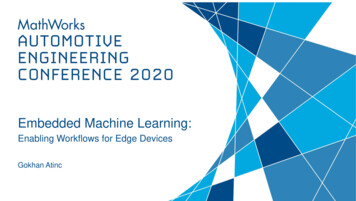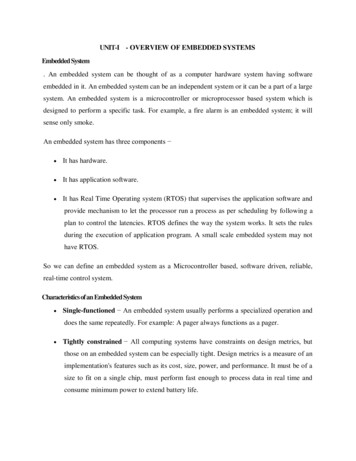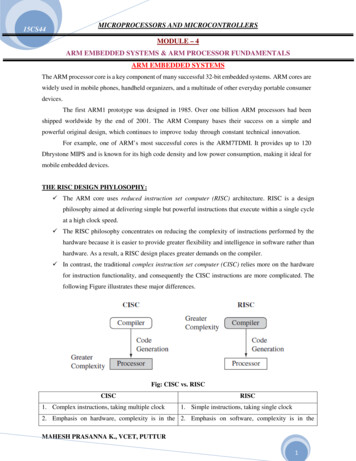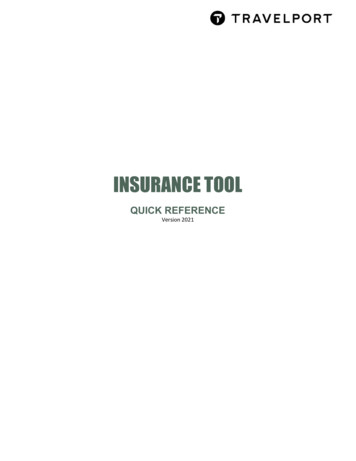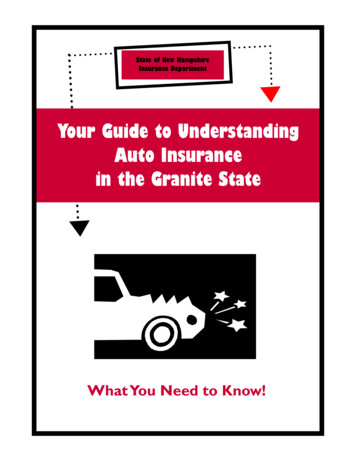
Transcription
RECORD, Volume 28, No. 3*Boston Annual MeetingOctober 27-30, 2002Session 91PDEmbedded Value of Life Insurance Product LinesTrack:Financial ReportingModerator:Panelists:BRIAN C. CAMPBELLNANCY E. BENNETTMICHAEL L. KASTERSIMCHA A. SEGALSummary: This session focuses on the methods and assumptions used to performembedded value calculations for various life insurance product lines. Discussionsalso center on practical examples of how embedded value is used to assistcompanies in the strategic decision making process. Comparisons to fair value andother methods of valuing performance of life insurance product lines are made.This session provides a learn-by-example format for acquiring knowledge and putscurrent theory into practice for more experienced practitioners.MR. BRIAN C. CAMPBELL: Our first speaker will be Nancy Bennett, a consultingactuary with Milliman USA in Chicago. Her consulting practice focuses on integratedfinancial management, including asset/liability modeling (ALM), investment strategydevelopment and risk management issues. Her specific modeling applications haveincluded cash-flow testing, embedded value analysis, appraisals, demutualizationsand profitability analysis. Her presentation today will focus on an overview ofembedded value, including such elements as internal and external reporting, someassumption choices and a discussion of the differences between fair value andembedded value.Our second speaker is Sim Segal, a senior manager with Deloitte & Touche in NewYork. Mr. Segal's areas of expertise include capital and risk management,embedded value, mergers and acquisitions (M&A) valuations, strategic planning and*Copyright 2003, Society of Actuaries
Embedded Value of Life Insurance Product Lines2bank insurance convergence. Sim's presentation will focus on the five stages ofmanagement usage of embedded value. Actually, it's going to really focus on threeof those five, and these applications will vary from the very basic to the veryadvanced.Finally, our third speaker is Mike Kaster. Mike is the managing director of actuarialpractice areas for the SOA. Mike's main focus is advancing the actuarial professionin the marketplace and helping to develop new areas of application for actuarialskills. His work includes the development of SOA strategic initiatives that will furtherthe skills of actuaries and enhance the profession's future. Mike will discuss aspecific case of a company's use of embedded value, including the variance acrossproducts, how to use embedded value for determining product mix and internalchallenges to the use of embedded value.With that, our first speaker is Nancy Bennett.MS. NANCY E. BENNETT: Thank you for the opportunity to speak with you today.I have to admit I'm a bit overwhelmed here by the response to this topic today, butI think that's encouraging because there is a lot of interest in embedded value, andit seems to be growing.Before I start though, I would like to ask just a general question of the audience.How many people have experience with embedded value or at least somefamiliarity with it? Okay, that's pretty good. A lot of you have direct experience.When this session was put together by the Society, it was listed for those with littleto no experience or no to moderate experience, and in deference to the Society,we did put some basic information in there. But I think given how much experienceis in the audience, I'm going to cover some of the basics pretty quickly. I won'tcover everything and probably won't cover every slide, but if there's anything thatyou want to go back and touch on, we can certainly do that.My piece of the presentation, as Brian mentioned, is to cover the basics ofembedded value, in particular embedded value as a financial reporting tool. In mypresentation today I'm going to briefly cover some of the factors that have beeninfluencing this increased use of embedded value within the insurance industry. I'llcover the basic embedded value fundamentals and then move quickly into thefinancial reporting aspect of embedded value.In the last couple of years in the United States, embedded value has been gaining alot of popularity. There are certainly many factors that have influenced this positivemomentum toward the increased interest and the use of embedded value. Forexample, in the last couple of years almost all of the major Canadian insurancecompanies implemented and started reporting embedded value to the analystcommunity. This actually followed their sister companies over in Europe and theU.K.
Embedded Value of Life Insurance Product Lines3I think part of the reason for this is that we're all familiar with the increasedsophistication of the products and the fact that the risk profile of insurancecompanies' balance sheets continues to shift. Demand seems to be increasing forpeople to be able to evaluate the financial results of insurance companies basedmore on the underlying economic fundamentals. People are tired of trying to wadethrough some of the accounting rules and some of the weird things that canhappen with the accounting, so there's a lot of interest in getting at the underlyingeconomic fundamentals. In tandem with that, and we'll see more of this,shareholders are becoming louder about their concerns with managementcompensation, and they want to make sure that the management compensationpackages are aligned with shareholder interest.On another note, also influencing the use of embedded value are the developmentsin international accounting. Within the international accounting community, there isa lot of interest in developing an international accounting standard that can be usedacross all financial institutions and industries. Although this is a long way from beingfinal and there's certainly a lot of discussion on it, the International AccountingStandards Board, which is one of the key drivers in this development, is leaningtoward an international accounting standard based on what they're calling fairvalue, which is really an interpretation or really conceptually quite similar toembedded value.On the flip side, some forces also have been holding back embedded value frombeing accepted across the industry on a widespread basis, and I think you'llprobably find most of the resistance within the United States. Clearly, within theUnited States almost all of us are required to do U.S. GAAP and U.S. stat.Embedded value becomes a third reporting standard for many companies, and ifthey're also part of a multinational insurer, there can be even more standardsbeyond that. So there is some resistance by U.S. company management, partlybecause the stock analysts in the United States have not really embracedembedded value.Just to get everybody on the same page here, let's start with some basics. Quitesimply, embedded value of a company is equal to the present value of earnings thatcan be distributed to shareholders, plus the market value of the free surplus. Theearnings that can be distributed to shareholders are based on statutoryrequirements. Earnings can be distributed to shareholders if first; the company hasretained sufficient earnings to cover the capital requirements. Anything above thatcan be distributed to shareholders. On a period-by-period basis then, the embeddedvalue added—or in the U.K. it's called achieved profits—is actually equal to thatchange in embedded value over time.You can tell from this definition that the focus of the embedded value is a measureof the creation or the destruction of shareholder value. I guess to put someactuarial jargon in here, embedded value is based on the actuarial appraisalmethodology or what's also called the indirect method in the actuarial literature. It's
Embedded Value of Life Insurance Product Lines4based on statutory accounting and statutory earnings. It's a little different in thatthe calculation explicitly reflects the company's cost of capital and retainedearnings.I'll just give you two formulas just to prove I am an actuary here (Figure 1). Thefirst formula is the basic value added formula. The value that is added to a companyin any given year is the difference between the embedded value from the beginningto the end of the period, plus any dividends that have been paid upstream, minusany capital that has already been injected by another entity. The second formula isreally just an expansion of the basic formula and illustrates the sources of earningsto embedded value.Figure 1Basic Embedded Value FormulasValue-Added (t) EV(t) - EV(t-1) Dividends Paid– Capital InjectedORValue-Added (t) Interest on free surplus Expected interest on inforce Value of current year’s new business Differences due to deviations inassumptions during current year PV of assumption changes for future years Model errors7The next two tables provide a template or a sample of how some companiesreport embedded value. Figure 2 shows how the basic embedded value is reportedand then Figure 3 shows how a company reports how embedded value haschanged from one period to the next. It's called the movement analysis, orsometimes it's called the variance analysis, but you can see that this basicallyshows what caused the change in embedded value from the beginning to the end ofthe period.
Embedded Value of Life Insurance Product Lines5Figure 2Embedded Value -- SAMPLE TEMPLATENo.12ItemIncome Before AdjustmentsPre-tax core incomeAfter-tax core income3456Locked-in Capital (LIC)200% RBC- Asset valuation reserve- Dividend liability Locked-in capital7After-tax surplus yield8910111213Shareholder DistributionsAfter-tax core income (vector from above) After-tax investment income on LIC- Cost of surplus note- Truly corporate expenses- Change in required shareholder equity Shareholder distributionsUnits US 000's US 000'sAtQ42000 US US US US000's000's000's000's%PV atQ42000(at HurdleRate - 1%) US US US US US USPV atQ42000(at HurdleRate)PV atQ42000(at HurdleRate 1%)000's000's000's000's000's000'sAtQ4200014Free surplus1516Control InformationPolicy countFace amount US 000'sAtQ42000No. of policies US 000's8
Embedded Value of Life Insurance Product Lines6Figure 3Embedded Value Movement Analysis -- SAMPLENo.1234ItemEV at Q3 2000Impact of errors discoveredImpact of modelling changesEV at Q3 2000 - Restated567891011121314151617Effect of Non-Economic Assumption Changes at Q3 2000MortalityMorbidityExpensesWithdrawalsRoll-over ratesAsset mix, asset prepayment, etc.Other (specfied in notes below)Effect of non-economic assumption changesEV at Q3 2000 - Restated w/ new assumptionsEffect of moving forwardEV at Q4 2000 - ProjectedExpected Shareholder DistributionEffect of new business production1819202122232425Effect of Deviation in Non-Economic ll-over ratesAsset mix, asset prepayment, etc.Other (specified in notes below)Effect of deviation in non-economic assumptions2627282930Effect of Economic Assumption Changes at Q4 2000Risk free ratesChange in spreads, otherHurdle rateOther (specified in notes below)Effect of economic assumption changes313233343536Effect of Deviation in Economic AssumptionsRisk free ratesChangeinspreads,otherExchangerateOther (specified in notes below)Effect of deviation in economic assumptionsEffect of changes in tax rules or legislation3738394041424344UntracedEV at Q4 2000Actual Shareholder Distribution UntracedManagement value addOperatingprofitsAchieved profitsOther (specified in notes below)Achieved profits, including "Other"9As you can tell from all this, embedded value is a prospective projection of financialresults. As such, the choice of certain assumptions is key and has a big bearing onembedded value. For just a moment, I'm going to touch on some of the majorassumptions that influence embedded value. Because it is a projection of acompany's cash flows—asset and liability cash flows, obviously—there are many,many assumptions involved in calculating embedded value. In many respects,embedded value is just a natural extension of cash flow testing or other projectionwork. One of the things that may be different is that a key component in calculatingembedded value is distributable earnings. This is based on realistic assumptions, andthere is no explicit provision or margin for deviation in those assumptions, unlikewhat you might find in other projections work.The cost of capital or the required capital is explicitly modeled in determining thedistributed earnings. In the work I've done, it's typically expressed as somepercentage of a published risk-based capital formula, such as a percentage of theNAIC's risk-based capital formula. I've worked with a company from the U.K. thatbased it on the Best’s Capital Adequacy Ratio (BCAR). I have seen one company
Embedded Value of Life Insurance Product Lines7that uses a proprietary formula, but most of the time I've seen the required capitalcalculated on a published or standardized formula.Then, of course, the big calculation is the present value of those distributableearnings. The present value of distributable earnings gives rise to a lot of questionsabout the discount rate. For the embedded value that is reported today by mostcompanies and in most countries, the present value is based on a deterministicdiscount rate. Although there's certainly a lot of rationale and logic to calculating thepresent value of distributable earnings using a stochastic process, at least thecompanies that I've seen that report externally just use a deterministic discountrate. Theoretically, this rate can vary by product line, but in my experience, most ofthe time the discount rate is the same for every product line.As I said, embedded value really can be calculated from your cash flow testingmodels, and you're going to hear more about implementation in a little bit. Butbefore we move off of the subject of setting assumptions and maintainingassumptions for embedded value, I just wanted to make a couple of commentsthat may be helpful if you're considering this or are in the middle of implementing it.Some of these comments or suggestions I would give you if you were doing anykind of modeling work, but some of them take on a lot of importance when you'redoing embedded value.Of course, it's always important to document your basis for making assumptions.That is especially important in embedded value because you will be updating theseassumptions over time. You want to have a clear idea of when you're going tomake changes to those assumptions and who's going to make them—whether thechanges will be made by the product areas, the corporate areas or whomever.Also, I think it's especially important that you understand how the assumptionsvary relative to other financial modeling applications. I always preach the use ofconsistent assumptions in all financial applications, unless you can come up with agood reason not to. I think consistent assumptions are very important. Forembedded value, the one I think may surprise you is that you may run into someproblems if you use different assumptions that have been used in pricing productsversus your in-force products that are probably modeled in your cash-flow testingsystem. The reason you may run into this consistency headlong is that withembedded value you will be reporting the embedded value created on your in-forcebusiness and also your new business. To extent the folks who are calculatingembedded value are using assumptions that are different than pricing, you'll end upat a minimum having some pretty interesting discussions about who's using theright assumptions. So, it's good to get that set upfront.If you're looking to do embedded value, you may wonder if there are anystandards of practice. Or if you wonder how you've done it compared to otherpeople, you may wonder if there are a lot of standards of practice. I guess theshort answer is no. There aren't a lot of published sources. It's basically developed
Embedded Value of Life Insurance Product Lines8from a lot of standard projection practices. I can alert you to three sources thatI've listed here (Figure 4). You can look at the Actuarial Standard of Practice 19 onappraisals. The Canadian Institute of Actuaries has published a draft standard oncalculating embedded value. And the Association of British Insurers has alsopublished a paper that includes standards for reporting achieved profits, and thoseare listed there.Figure 4Standards of PracticellNot many published sourcesDeveloped from typical practices forappraising business and other projections– ASOP 19lCanadian draft standard (CIA)– www.actuaries.ca/structure/psc/rava/embedded value-e.pdflABI paper on standards for publishing MBER 2001 - FINAL VERSION.DOC13I strongly believe that embedded value is a very valuable tool for helping acompany decide what strategic directions it wants to take—how it should beallocating capital and other resources. But you will find that the financial reportingaspect of embedded value will probably be the first and most visible application ofembedded value. Once you get comfortable with reporting embedded value, youcan move into some of the fun stuff that goes along with embedded value. Butgiven the importance of financial reporting, it's essential that we understand howthe financial results are reported in embedded value and, in particular, how thoseachieved profits or economic value added (EVA) numbers compare to the reportedresults in other accounting systems.I'm sure that everybody is probably painfully familiar with U.S. stat and U.S. GAAPrequirements. The problems with U.S. stat and GAAP are well-known anddocumented, and we could probably spend a lot of time talking about that. But Ithink many of the criticisms of these two accounting systems stem from the usersand the purposes of those financial statements. One of the reasons that embeddedvalue came into existence, in many respects, was to respond to some of thesecriticisms. Though it wasn't developed directly in the United States, the embedded
Embedded Value of Life Insurance Product Lines9value reporting system is intended to measure how decisions affect shareholdervalue. In fact, embedded value is intended to measure economic profits.So we're really dealing now with three different accounting systems. I don't want togo too far afield here, but I did think it would be useful if I touched on thedevelopments with international accounting regarding recommendations dealingwith fair value. As I mentioned before, the issue of fair value is fairly contested rightnow, and there are a lot of different, fairly strong opinions on both sides as towhere international accounting is going to go and, in particular, how that's going toinfluence reporting within the United States. But the International AccountingStandards Board (IASB) is one of the big forces that are looking to develop adifferent accounting standard. The purpose of this new accounting standard is todevelop a reporting system that can be used for all readers of the financialstatements, whether you're a regulator, a shareholder or management.The IASB has started to go down a pretty solid path of wanting to use marketvalue as their basis for reporting the value of a company. As all of us within theinsurance industry know, there isn't always an observed market value, so they aredeveloping what they're calling fair value as the proxy to market value. The IASBhas looked at the different ways of calculating fair value. It's not hard to get marketvalue of assets, but the problem, of course, is on the liability side. They'veexamined both this indirect and the direct method of calculating the value of acompany, and they have landed on an approach that calculates fair value using thisdirect methodology. I'll get into that in a little bit more. One of the reasons they didthat is they are fairly convinced that the direct and indirect methods can be equatedwith the proper choice of assumptions. So what this all means is that the IASB isrecommending an approach to use fair value as a proxy to market value that isreally a derivation of embedded value, or really a first-cousin.If I provide a brief background on the IASB developments, I think you will see thatthe search for an international standard has put even more emphasis on andinterest in the embedded value concept. As I said before, this fair value proxy is notquite defined yet. There are still some very important technical issues that are beingworked out, but at least the concept of fair value seems to be what is being pushedfrom the IASB's concept. Fair value would be market value, and where that is notavailable, they're developing something called entity-specific value. I think it wouldbe similar to what we consider fair value of liabilities or the present value of theliabilities cash flows.With respect to the fair value, one approach would be used for all insurancecontracts, again, based on market value. This would be a direct calculation. In otherwords, the company would calculate the market value of the assets and themarket value of the liabilities. The difference between the two then would give youthe value of the company. So that is contrasted to the embedded value approach,which is the present value of just the remaining distributable earnings. The IASB has
Embedded Value of Life Insurance Product Lines10taken embedded value one step further, in that the stochastic processes will be apart of valuing the fair value of the liabilities.Now, there are a lot of strong opinions on IASB and whether or not it will goforward. Clearly, the United States will have a big influence on that. I'm not here topredict the resolution of this issue, but clearly, the fair value movement has seen alot of activity in the last few years. With the increased market share of multinationalinsurers, I think it's really important that the actuarial community at least has abasic understanding of this issue because I think it obviously has a direct bearing onour work.I thought that it would be useful to compare and contrast how earnings can bereported differently, depending on the accounting system. I want to talk about howthe timing of profits can change. The timing of profits is going to depend on six keyrules that are really no different than those for dealing with statutory and GAAPearnings. I'll just briefly cover them.One is the type of insurance. As I mentioned, the International Accounting Standardis not looking to have a standard that varies by insurance contract. They don't careif it's short-duration, long-duration, investment or an insurance contract— onestandard for all. Some of the accounting requirements, of course, tell you how tocalculate benefit reserves. They tell you how to recognize expenses. Once you getthe product issues, they tell you how you have to recognize the expense, whetherit's upfront. Once you've done that, then they tell you the only thing you do knowwith insurance is that you're going to be wrong at issue. So, how do you recognizechanges in experience over time? Do you just ignore it? Are you locked in at issue,or do you take an immediate hit when the experience changes?The bottom line when you're looking at the timing of profits is that the rules dodetermine how the profits will emerge, the tim ing and the instance of thoseearnings. What you'll find is that with embedded value or embedded value added itwill be more volatile than either statutory or GAAP. I'm sure there are probablysome examples where that wouldn't be the case. But I think the primary reason forthat is it makes sense because embedded value is not hampered with any of therules of GAAP that say revenue and expenses have to be matched. There aren'tany rules that say when you can or can't recognize changes in experience. So,bottom line, you're going to have much more volatile earnings with embeddedvalue.I guess to some extent, that's probably not that surprising because you're dealingwith insurance cash flows. We all know that insurance cash flows are uncertain. Wereally don't know what they're going to be. And this very uncertainty is whatcreates the challenges in preparing and understanding the financial results,regardless of the reporting system, and embedded value is no exception. There arecertainly a number of critics who can talk about embedded value and its limitations.But first and foremost, embedded value is a system that focuses on the creation or
Embedded Value of Life Insurance Product Lines11destruction of shareholder value. It really isn't concerned with anything else—policyholder value, how company actions affect employees or the communities,other stakeholders in the enterprise. It is solely focused on how actions increase ordecrease shareholder value. It takes a long-term view. It's not so concerned withshort-term, monthly or quarterly changes in earnings.Despite its many limitations I do believe—and I think you'll see this demonstratedlater—embedded value is a very powerful financial management tool, and it canprovide a company with a lot of good information to help manage the company.Embedded value can provide companies with information that they probably can'tget from any of the other financial systems that they may be trying to use. Ifembedded value is institutionalized completely, it can be a very effective system fornot only reporting and understanding period-to-period financial results, but also toallocate capital to new ventures and to help direct the activities and resourceswithin the company with a singular focus on increasing shareholder value. With that,I'll turn it over to Sim, so he can talk about some of the management applications.MR. SIMCHA A. SEGAL: I'm pleased to be able to share with you today some ofour thinking on embedded value in the context of the larger framework, effectivevalue-based management. The title of the presentation is "Climbing the Ladder toEffective Value-Based Management." We're going to start by discussing selectingthe appropriate measure or measures and the different uses for which it'sappropriate. Then we're going to move onto the five sequential steps that arecritical to getting the most lift out of a value-based management approach, but weonly have time for three of those today. Then, I'll touch on some implementationissues because Mike is going to follow with some deep dive and some greatdiscussion on implementation. Finally, I will summarize with keys to success.There are many measures in value-based management—fair value, embeddedvalue, shareholder value, appraisal value and market value, for example. The onlything that's certain is value. You obviously have to have that if you're managing forvalue, but which ones and for what purposes? So let's take a look at two that youmay be familiar with.You're familiar with the definition of embedded value, and Nancy did a great job ofgoing over the definitions. These are very similar. In Figure 5, the embedded valueon the right equals the value of the surplus, plus the value of the in-force business.Both of those, you'll notice, are distributable. You only give value from distributable.These assumptions are that when something is distributable, it is distributed. So ifyou have distributable surplus, which is the excess of total surplus over that whichis required, or target, surplus, then you distribute it. You don't have it as fallowcapital existing as a drag. You just pay it out when it's distributable. In thispresentation you have target surpluses, which I think more appropriately belongalong with the value of the in force and that, then, is the discounted value ofdistributable earnings from the in-force business. So that's the embedded value.
Embedded Value of Life Insurance Product Lines12Figure 5EV and SV reflect internalexpectationsDiscounted value of distributableearnings from future newbusinessValue of futuresalesDiscounted value of distributableearnings from inforce business*Value of inforceDistributable surplusValue of surplus* Includes target surplusEmbeddedValue (EV)ShareholderValue (SV)5When you add the value of future new business and this discounted value of thedistributable earnings from the future new business, you get shareholder value.Now, as it's defined here, some of you may be saying, "Wait a minute, that'sappraisal value." This is a bit of a different definition. There's a subtlety that I wantto bring out. Shareholder value, as we're using it here, is an internal calculatio n. It'snot an appraisal value that an acquiring company would pay for a business basedon market supply and demand, and it's not a calculation of the internal company ofwhat it can sell this for, given the market prices. It's just an internal best estimateof what your management thinks inside the company that actual shareholder valueis as a going concern.Why do you need shareholder value? You have market value; what do you need itfor? What one thing does a disreputable stock trader want? They want insideinformation. They can get inside your company and look at what your managershave, get access to that information. That gives them a much more accuratepicture of what the true stock price is and what the market value should approach,over time. Then they can arbitrage the stock price.But there's a problem with that. There's management bias in the information youhave. Why could somebody come into your company and get that insideinformation and then use it when they don't have any biases? Often there arebiases when you're involving new business projections due to the nature of the
Embedded Value of Life Insurance Product Lines13planning process, incentives or the political environment. You don't necessarily getthe most credible new business projections. You often get that hockey stick wheregrowth is low, and it's going to take off in the next few years. So the key is to fix itby applying a very disciplined, rigorous process of setting and changingassumptions.Some top 10 insurer is actually using a cr
first formula is the basic value added formula. The value that is added to a company in any given year is the difference between the embedded value from the beginning to the end of the period, plus any dividends that have be en paid upstream, minus any capital that has already been injected



